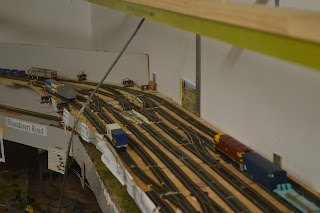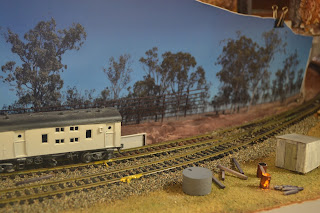After
making changes to the timetable following last weekend's trial operations, I
decided to continue to fuel my progress - so to speak. So yesterday I spend time with
No. 49 the Down Fuel train from Grafton to Old Cassino and Lismore. The
train after leaving Grafton Staging, and heading though Rappville Loop, it takes the back platform road at Cassino and then runs into the yard at
Old Cassino. From here it backs into the Shell Oil Siding. I have
rearranged the wagons on this train. I also added an open wagon, which
will contain a load of oil and other petroleum based product drums. This
wagon will be the last vehicle on the train and will be positioned alongside the
case store in my Shell Oil Siding. There will also be a visiting Ampol
NTAF, along with a short wheelbase Shell tanker and a Shell NTAF. These
four wagons will be cut off and the train will proceed to the next town –
Lismore to so some similar shunting. It must be remembered when shunting
the Oil Sidings on my layout, that the loco cannot travel past the gates. The track is poorly maintained and cannot handle the weight of a loco.
At Lismore,
the train which still has two Shell Oil Tankers and two other tankers on the train destined for the Shell Oil Siding in this town will
travel into the platform road at Lismore, and then shunt back into the Shell
Oil Siding after first making sure that the gates have been opened. The
train still has a Speed-e-Gas tanker on the front, and this enables the wagons being dropped off
to be positioned inside the gates of this private siding. I am still at least one oil tanker
short for this train, and if possible, I might swap out my two non-descript (other) oil
tankers when the Eureka ones hit the market. Once the oil wagons have been
dropped off, the train now only hauling the gas tanker, heads through the
platform again and into the yard. As the train was leaving the siding, the
shunter ensures that the gates are closed and locked before heading to the platform.
Once through the platform the train then reverses back into the gas unloading
frame located in one of the sidings in the yard at Lismore with the loco stabling in the siding until it
needs to haul the train back south.
A number of
hours later the loco of now no. 50, the Up Fuel Train hauls the now empty gas
tanker into the yard and runs around the tanker via the main line. The
train then heads back through the platform and travels to the far end of the
Shell Oil Siding at Lismore. The train, then shunts back onto the now
empty oil tankers. Again a check is made to ensure that the siding gates
are opened before heading in. Once coupled up, the train is pulled clear
of the gates and then the train is left there, while the gas tanker is pulled
forward and then pushed back and left on the main line clear of this set of
points. The loco then sets forward again, and then pushes back onto the
oil rake again. Ones coupled, it pulls forward and then when clear of the
points, sets back onto the gas tanker. This positioned the gas tanker in the correct position for the next timetable run. The shunter then closes and locks
the gates to the Oil siding, and the train heads south to Old Cassino.
At Old
Cassino, the train heads to the platform road. The loco uncouples and
then runs around the train via the yard track. It then couples up to the
northern end of the train and then the train is propelled back into the Oil Siding.
It collects the three empty oil tankers and the open wagon, now loaded with
returning empty drums of oil and petroleum products. Once coupled, up the
train heads back to the Old Cassino platform road, and the loco then uncouples and then runs
around the train again, and then sets back onto the open wagon at the now front
end of the train. The train then resumes its journey south through Cassino, and
Rappville Loop, past the Rocla Sleeper Siding and into a free track in the Grafton
Staging Yard. The loco then uncouples and runs around the loop and comes
back and couples onto the other end of the train. The train then pulls
forward out back onto the mainline and once clear of the point to the dead end sidings,
shunts back into its designated siding, all ready to begin the trip during the
next exercising of the timetable in late August.
So that is
the testing of the Fuel Train. The two timetable cards, for No. 49 and No. 50 have been adjusted
with the current activities to be performed and the shunt list has been adjusted
to include the additional open wagon in the consist.
This
planning and trialling was not without its headaches. With the additional
wagon in its load, the Fuel Train now does not fit in its designated
siding. So a number of changes have been made to the trains located in
the dead end sidings at Grafton Yard. The Ballast train that was the
source of last week’s testing, has moved from track 9 to track 8. The
Fuel train which was in track 10 has now moved to track 9. The Sleeper
train which was in track 8 has now moved to track 10. All the timetable
cards for these trains have also been adjusted.
With plenty
of work to do, but no motivation to do any, I do a couple of small tasks as well yesterday. I did add about 75mm of track
length to the Oil Siding at Old Cassino, so it can now comfortably take the 4 wagons
it needs instead of the three it previously held. While working on the
run-around movement for the gas tanker at Lismore, I decided to bite the bullet
and install a small through girder bridge over a road underpass on the northern side of
Lismore. I cut the track out, spliced in a length of bridge track that I
had left over from when I installed the kitbashed bridge at Cassino over the Richmond
River. The styrene structure of the over bridge also ended up being thicker
than the cork roadbed under the adjacent track at Lismore, and you guessed it,
I had already ballast the track down in Lismore. Bugger! Anyway,
there is now a slight rise over the last 5 centimetres before the bridge.
On the other side I have had to pack under the track as the first train through
there uncoupled between the loco and first wagon. As part of the
testing of the bridge, I ran the container train that was sitting at
Murwillumbah back and forth through the bridge and I ran the motorail from
Grafton back and forth through the bridge. The reasons that I did this,
is that the bridge is on a slight curve in the track geometry and the styrene
bridge base that I scratch built ended up being rather narrow given the curve
was involved. Whoops, I wish I had my time back again. I would have
made the bridge another 5mm wider.
Anyway,
everything ran through smoothly. Future activities in the lead up to the
forthcoming Operating Session will involve cleaning the track and printing out
the timetable cards and the new timetable graphs. Oh that's right, I still have a short that appears intermittently somewhere between Dutton Park and South Brisbane Interstate when I throw the points at Dutton Park to Fisherman Islands.
Next weekend
will be spent at my Club’s Model Railway Exhibition at Strathpine north of
Brisbane. I will be spending most of my time on the door, so say g’day if
you come along for a visit.
























